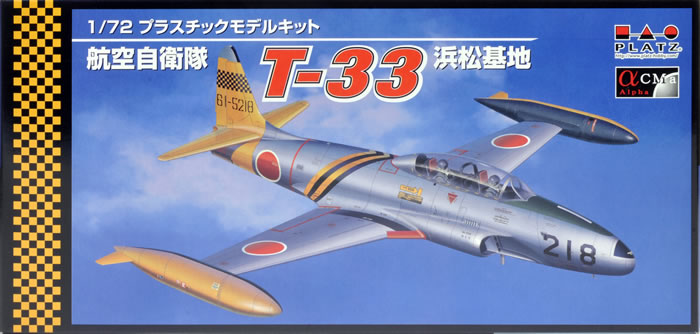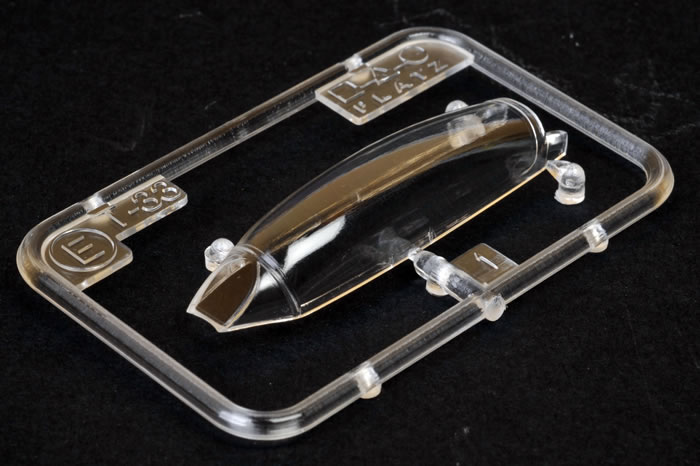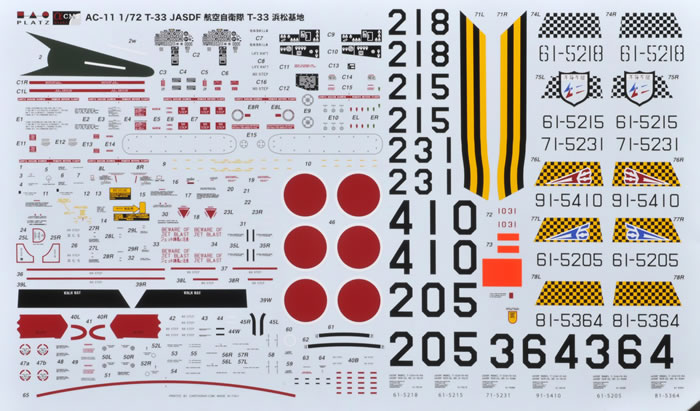Lockheed T-33 Shooting Star

Platz, 1/72 scale
S u m m a r y : |
Catalogue Number: |
Platz Kt No. AC-11 - Lockheed T-33 Shooting Star |
Scale: |
1/72 |
Contents & Media |
One clear styrene and fifty-five grey styrene parts, plus decals for six subjects. |
Price: |
Available online from: |
Stockist: |
Platz Models |
Hobby Link Japan |
Price: |
¥2,376 |
¥1,760 |
Review Type: |
First Look. |
Advantages: |
Accurate, very good quality moulding, nice surface detail, innovative tackling of the air-intakes, and excellently printed decals. |
Disadvantages: |
Markings options will probably have limited appeal outside Japanese home market. |
Conclusions: |
This is a very nicely engineered kit produced to high standards. It remains the most accurate and easiest to build T-33 kit.
The design of the intakes is simple but clever, and superior in my view to the way previous kits have addressed this aspect of the T-33’s airframe. The decal options are frankly a bit boring given the range of international possibilities the T-33 offers.
This kit has the potential to produce a very good model of the T-33, but you will need either some Pavla seats or suitable seatbelts to do your model full justice. Those who relish resin detail may be tempted to buy the cheaper, harder to build and slightly less accurate Sword kit however.
Over the years I have changed my view of this kit relative to Sword’s, and would now opt for Platz in preference. What a pity it is not more widely distributed - Highly recommended. |
Reviewed by Mark Davies

HyperScale is proudly supported by Squadron.com
The first US jet aircraft was the Bell P-59, but an altogether better design that flew just a little later was the Lockheed P-80. It was the product of a brilliant Lockheed “Skunk Works” design team led by “Kelly” Johnson. The first airframe was developed and delivered within a staggering 143 days, and the prototype first flew in January 1944. Just missing combat in WW2, the P-80, later to be redesignated F-80, was to see active service as a fighter, fighter-bomber and photoreconnaissance platform in the Korean War. Although the superlative F-86 Sabre already soon overshadowed it in the fighter role.
Early on Lockheed had suggested the development of a two-seat P-80 to the USAF, but the air force brass did not appreciate the need for a jet trainer at the time. However, as the difficulties in transitioning from piston-engined types to jets became more apparent there was a change in official thinking by 1947.
Developed form the P-80C, the TF-80C (soon to be redesignated T-33) introduced tandem seating and a long canopy. A 26” plug was inserted in the cockpit area, and the mid-fuselage was extended by a further 12“. An armament reduction from six to two .50” M3 machineguns occurred (although many T-33’s had no guns fitted). It first flew in March 1948.
The T-33 was an outstanding success and widely exported to over 30 countries, as well as being licence-produced in Canada and Japan. Light attack and photoreconnaissance variants were also developed. The design was further developed and highly modified for US Navy use, and known as the T2V –1/T-1A Seastar. This had a raised cockpit line, leading-edge slats, tail hook for carrier landings, and was the first US aircraft to have boundary layer control using engine bleed-air. Lockheed also developed a radar-equipped after-burning all-weather interceptor derived from the T-33; called the F-94 Starfire.
T-33 production reached almost 6,600, and several are still flying in private hands as warbirds.
1/72 T-33 Shooting Star Kits
I am aware of three other brand T-33 kits in 1/72 scale. Hasegawa’s was the first. It an old kit with fine raised panel lines, rather basic detail levels, and offered in several different boxings over the years (it may have been re-boxed by Frog as well). Heller produced a very nice kit some time after Hasegawa. This also has raised panel lines, but offers superior levels of detail and I have read that it is the more accurate of the two.
Around about mid-2010 Sword released a modern limited-run multi-media kit, which I reviewed here on HyperScale. This is a good kit with plenty of resin internal detail, and comes in at least two boxings with a range of decal options.
Since reviewing the Sword kit I have been advised that it has some accuracy issues and is surpassed in accuracy by the Platz kit that has been around since at least 2012. (See this post on “Plane Talking”.)
Overview
The kit comes in a typical Japanese top-opening box made from good quality glossy card. Written instructions are predominantly in Japanese, although it provides the aircraft’s history in English. The instructions are easy enough to follow with simple but clear diagrammatic assembly stages. Colour call-outs are I suspect related to the Gunze Sangyo and Mr Color paint ranges, but most useful is that they provide FS-595.codes as well. The parts come enclosed in a plastic bag, with the clear parts and decals further protected in their own bags. As with other Platz kits I have reviewed, I found crisply moulded parts with delicate engraved panel detail. However the undercarriage doors have sink marks present, but these should be easy to deal with.
The Kit
Cockpit detail is quite reasonable for the scale, with crisp raised detail on the instrument panels and consoles; there are decals for these parts as well. The seats are an acceptable facsimile of the real thing, although moulding the footrests with the floor does fails to capture their true appearance. The clear canopy is also well done, but is a single piece. This is something that those who choose to buy Platz’s separately available PE detail set may regret, as they will have to cut the canopy to show off the interior to best advantage.

Parts breakdown is a little unconventional for this subject. Other T-33, and for that matter P-80, split the air intakes from mouth to duct horizontally, incorporating the top part with the fuselage and the bottom with lower the wing halves. This in turn makes for some awkward joints and filling issues. Platz has a very simple and effective solution that avoids joins in the intake mouth area. They mould the mouth and first part of the intake duct as one piece that is deep enough to provide the internal ducting as well. The intakes attach to the fuselage and wings along simple straight join lines that I doubt will need any filling, but if they do will be easy to access.
The other unusual feature of the kit’s parts breakdown is the separation of the fuselage at the break-line for engine removal. There is internal structure detail inside the rear fuselage and a bulkhead with holes for intake ducting just behind the cockpit. This all suggests that an engine was to have been included, or will be in a future edition. The kit provides instead just a long exhaust duct and nozzle. I hope that the added complexity of the additional fuselage join will not present any problems.
In all other respects the parts breakdown and constructional sequence is conventional. There are separate air brakes and acceptably detailed undercarriage parts, but there is nothing out of the ordinary in terms of detail or finesse.
Since first reviewing this kit a couple of years ago I have learned that it has the more accurate tailplane and tailfin shape when compared to the Sword or Heller kits (Hasegawa’s is OK), plus it is the only kit to feature a wing root edge glove vane. It reportedly trouble-free to build.
Colours and Markings
Markings options are all for six Japanese Air Self Defence Force machines. All are similar same bare metal schemes, with some having orange tails, orange and black tip-tanks, or chequered tailfin bands. The most colourful is that featured on the box-art with four diagonal stripes on the fuselage. The decals look to be excellent, with very good registration, and suggest good opacity. They include a fair amount of stencilling. The inclusion of the anti-glare panel and wing walks is also a nice touch. The painting and markings guide is very clear and thorough.

Platz offer two other boxings of schemes kit, one with more JASDF schemes, and the other in a “Spirit of 76” bicentennial scheme (despite being described as USAF on the Platz website).
There are plenty of international schemes with wider export appeal, but I fear Platz may lack enough international distribution to make this worthwhile. Still, I would encourage readers to hunt down this T-33 and other Platz kits. They do a very nice 1/72 Mitsubishi F-1 (and a T-2 planned), some good UAV’s and some delightful 1/144 scale planes to mention just some I have seen.
This is a very nicely engineered kit produced to high standards. It remains the most accurate and easiest to build T-33 kit.
The design of the intakes is simple but clever, and superior in my view to the way previous kits have addressed this aspect of the T-33’s airframe. The decal options are frankly a bit boring given the range of international possibilities the T-33 offers.
Detail levels are quite adequate. For those prepared spend extra money (more than half the kit’s cost) there is a Eduard PE set by Platz that goes some way to dressing up the cockpit (but lacks seat-belts!), and to a lesser extent the wheel-wells. It is better to spend any extra funds on Pavla resin seats and some after-market decals in my view (unless you wish to build a JASDF machine).
This kit has the potential to produce a very good model of the T-33, but you will need either some Pavla seats or suitable seatbelts to do your model full justice. Those who relish resin detail may be tempted to buy the cheaper, harder to build and slightly less accurate Sword kit however.
Over the years I have changed my view of this kit relative to Sword’s, and would now opt for Platz in preference. What a pity it is not more widely distributed.
Highly recommended.
Thanks to Platz Hobby for the review sample.
Review Text Copyright © 2013 by Mark Davies
Page Created 7 April, 2013
Last updated
21 April, 2014
Back to HyperScale Main Page
Back to Reviews Page

|
Home
| What's New |
Features |
Gallery |
Reviews |
Reference |
Forum |
Search